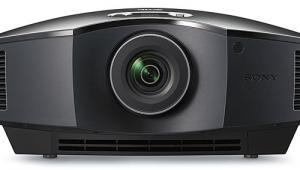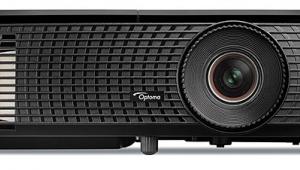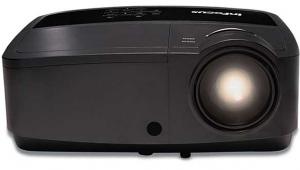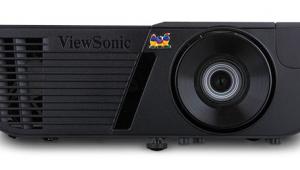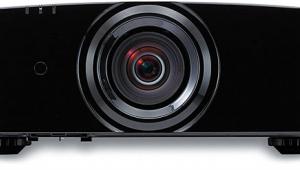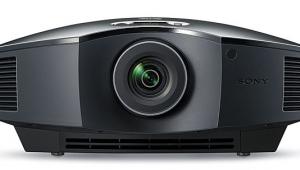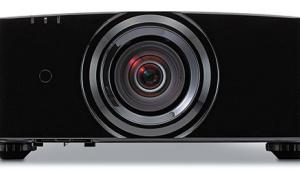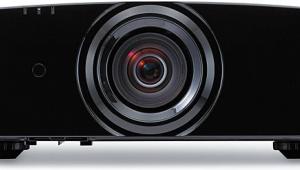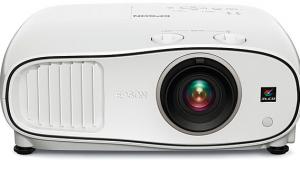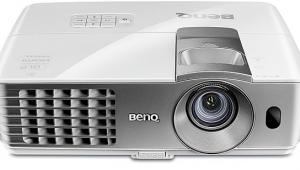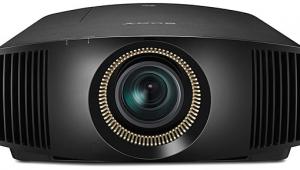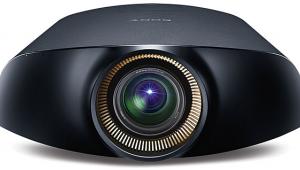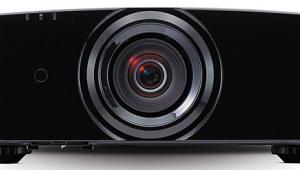I think you guys got the 2D and 3D score flipped around at the performance rating.
BenQ W7000 3D DLP Projector

It seems like only yesterday that DLP was the belle of the ball for front projector technologies. Oh, how things have changed these last few years. Now we see a polarized market made up of budget entry-level offerings or cost-no-object three-chip designs with little in the way of middle ground. I don’t know how much this has to do with Texas Instruments almost abandoning development of consumer-based chips (we haven’t seen any developments in DMD design for quite some time) or consumers’ leaning toward the higher contrast numbers of LCOS and SXRD designs. Or maybe it’s the price/performance that LCD has brought to the table. One thing is for sure, though: DLP is still a very capable technology that, when properly implemented, can throw a mesmerizing image. And now with 3D being a key feature in the market, maybe it’s time DLP’s popularity got a significant boost.
Let There Be Light
I’ve reviewed quite a few BenQ projectors over the years. During the heyday of mid-priced DLP offerings, BenQ designed
some great price/performance machines that received some
high recommendations from me. Unfortunately, the company’s last few offerings have had some issues, and BenQ fell off my radar for a while. But the new W7000 looked like a promising piece of kit that hits some much-needed notes for people looking for a solid 3D projector for big screens.
The BenQ W7000 is one of the few DLP projectors in the value market that I would refer to as having a true home theater design. It doesn’t have any weird fixed offset lens issues to deal with, and its architecture makes for an easy install. Its all-glass 1.5x zoom lens has a throw range of 1.6 to 2.4 and features both horizontal and vertical lens shift, which seems to be a rare feature for budget-oriented DLP designs recently. The lens shifts via a small joystick that you can tighten down after you’ve reached the desired position. It’s similar to the joystick on Panasonic projectors. The lens is quite good, with no signs of chromatic aberration and nice focus uniformity. Pixel focus was solid, though not quite as tack sharp as some of the higher-end DLP projectors I’ve used in the past. Still, considering the W7000’s price point, the performance was better than I expected, and it delivered a very crisp image on my large screen.

The W7000 uses one of the older DLP Digital Micromirror Devices (DMD), the Dark Chip 2 (DC2). This chip has been in the market for quite some time and doesn’t typically have the contrast performance of the higher-end Dark Chip 3 or 4 DMDs. The projector has a 6x color wheel (RGBRGB) that has a speed of 6x in Dynamic mode and 4x in Standard and Cinema modes. I don’t consider myself overly sensitive to color-separation artifacts commonly referred to as rainbows, but I did see quite a bit of them with this projector. It was mainly in higher-contrast scenes or if I happened to move my eyes around the screen a lot.
The W7000 employs Texas Instruments’ DynamicBlack system to improve contrast performance with a dynamic iris. This had a negligible impact on contrast (more on this later) and was a bit loud during operation. In quiet passages it was noticeable from time to time, but with most content I couldn’t hear it over the normal audio program.
Hookups for the W7000 are generous and include two HDMI 1.4a inputs that are compatible with the latest formats, includ- ing 3D. You’ll also find all the requisite analog connections, including a composite video, S-video, and component video input. BenQ also includes a VGA input and RS-232 serial connection, along with a USB input and 12-volt trigger output. The W7000 is a full 3D-capable projector that’s compatible with DLP-Link 3D glasses. The emitter is built into the projector, so a separate emitter is not required. The W7000 doesn’t come with 3D glasses, but for this review, BenQ sent me a pair of its 3D goggles ($129). I can’t say I was a fan of the glasses; they were quite heavy on my nose, and the padding was less than ideal. These are probably the most fatiguing glasses I’ve worn for 3D playback, but since the W7000 is a DLP-Link-compatible projector, you can opt to use any DLP Link glasses or wait to check out the redesigned glasses BenQ expects to release this summer.
While the W7000 isn’t based on a business projector design, it does share a similar feature that sets it apart. It’s extremely bright. BenQ rates the lumen output at 2,000 lumens, and this is one of the brightest projectors I’ve used in my room. I set up the projector 14 feet back from my 120-inch-diagonal Stewart StudioTek 130 screen (1.3 gain), and with the lamp in Economic mode (low), I achieved nearly 24 foot-lamberts. If I switched over to Normal lamp mode (high), that number went up to about 29 ft-L. That’s about twice as bright as my reference JVC DLA-RS35. And while I don’t really need that kind of light output in my pitch-black theater room, it makes all the difference in the world for 3D playback, which typically robs more than 75 percent of a projector’s light output. In this case, 3D playback resulted in a measly 3 ft-L through the glasses. I find this bizarre, though; the light output when viewing looked much brighter than this. I didn’t feel like the image was dim at all when I watched 3D, even with darker material.

The included remote is similar to the remotes I’ve used with previous BenQ projectors. It’s on the large side but fits comfortably in your hand. All of the buttons are clearly labeled, and the remote lights up with a push of a button on the bottom. Presets and most of the aspect and picture controls are there. Overall, it’s one of the better remotes I’ve used.
Setup
Setting up the BenQ was a bit tricky, but I managed to produce a very respectable image out of it at the end of the day. The menu system is simple to navigate and features everything anyone needs to get the most out of this projector. There’s a password-protected ISF menu that offers a few more calibration tweaks, but it doesn’t really give you anything more than what you can do from the main menus.
The picture settings are broken down into two menus: Basic and Advanced. Not only do you get the customary basic controls for color, tint, brightness, and contrast but all the advanced features like a full color management system (CMS) and calibration tools for gray scale.
BenQ includes a mix of presets for different material. I did what I always do and just went right for the User 1 preset to dial in the picture myself. The W7000 has different options for HDMI input settings. There are Auto, Video, and PC setting. The Video setting clips below-black and above-white values (digital 16 and digital 235), while the PC setting allows for head- and toe room. For this review, I stuck with the Video preset despite the fact that I typically prefer a bit more headroom than digital 235 pro- vides. Since this is a Dark Chip 2 projector, I wanted to preserve as much contrast as possible from the design while also providing as much brightness as possible for 3D playback. I made all of the settings with DynamicBlack off to make sure it wasn’t causing any gamma distortion to my settings. Once I had it dialed in, I turned on Dynamic Black for normal viewing.
Setup wasn’t quite as cut and dried as some of the other projectors I’ve reviewed recently. While brightness and contrast were nearly spot-on right out of the box, sharpness wasn’t. Typically, this is a setting I place at 0 right off the bat to eliminate any ringing that the sharpness control adds to the image. But when I set the W7000 to 0, it resulted in some rather nasty scaling artifacts. When I looked at a resolution burst, I saw obvious artifacts, including moiré and rolloff. When I set the sharpness control to 5, it eliminated the artifacts and provided the most accurate picture, but there were still some slight scaling artifacts in some of the resolution charts.
- Log in or register to post comments



Ok thanks Mr. Sabin. I must be going crazy cause at first I swear it showed 2D at 5 stars and 3D at 3.5 stars. I think someone corrected it or I could be crazy lol. Looks good now tho. Thanks Rob

First, thank you Mr. Deering.
So, do you post, or still have, the calibration settings you used? I was unable to find them, unless I really skimmed through the article too fast.
Also, when you referred to the setup like a local cinema, were you referring to a darkened room that has dark paint/panels? Or, are you just referring to black levels being less inky in theaters?
I have a 30-Day trial on a W7000, but was not sure if I should pay the extra $600 for the Epson 5010. I do want to be able to play video games in the long run, but I have a controlled environment where the neighboring panels are dark, and absorb light rather than reflect it back. The room basically seems dark.
Your thoughts and feedback will be greatly appreciated. Especially since 3.5 out of 5 is a big deal for me on 2D performance.
-Stringfellow



I applied all the settings, but noticed that on my machine the Flesh Tones max out at 5, whereas the Sharpness maxes at 2.
You noted Sharpness is set to 5, and Flesh Tones to 0.
1) Should those two numbers be reversed?
2) Also, would applying these settings to Cinema mode be beneficial
3) And, is there any harm in keeping the Lamp Setting in "Normal," mode?

For whatever it is worth, like Christmas, we give gifts at the end of Ramadan, which is during the celebration called Eid-al-Fitr. Your most generous responses, irrespective of the truth that calibration is subjective based on the environment it is being done in and your initial reply about the D-Cinema and its relationship to DLP, were by far the coolest gift, yet.
Thank you! :)
-Stringfellow
PS. I have tried Art Feierman's settings (from Projector Reviews), and it looked pretty amazing. Initially, he had some issues with certain colors (I think cyan???), but they were mostly resolved in the updated model he received (new firmware). I will compare the two settings this week and let y'all know what I thought. Also, I am saving up to potentially get it professionally calibrated, but I have to wait a little while for that.

Were the reviewers able to compare the W7000 to the previously reviewed (and since revised-review) Sharp XV-Z30000? Specifically for 3D, how does the brightness compare with decent color? How does the brightness compare in brightest mode for 3D? The W7000 is certainly bright (especially calibrated in 2D), but loses a bit of oomph in 3D... is it significantly brighter in 3D (calibrated and brightest)than the XV-Z30000, which has better 2D performance?

I am looking at setting up my Home theatre and am considering the BenQ W7000. The room size is 17.5 ft x 14.5 ft. I plan to ceiling mount the projector at the back of the room and so approx throw distance would be around 15.5 ft. This is a dedicated media room but has windows and hence the ambient light - I possibly would use dark curtains. I was planning to go with a 140" diagonal screen. I want to know if a 140" screen will be good for both 2D and 3D movies viewing or will I lose some picture quality with that big a screen. Also given my room size will I be able to get a 140" image.

Anyone has suggestions on this? Thanks.

